Top 10 Deadliest Snakes in The World
“Which is the world’s deadliest snake?” That’s a question that almost every outdoor enthusiast has pondered or questioned. Snakes are formidable predatory animals. They can execute a bite lethal enough to kill animals several times to their size. A king cobra’s bite, for example, can kill an elephant. Certain species depend on poison for feeding and self-defense. Even though snakes have such a stronghold on the human consciousness, the creatures aren’t after us. They screech, slither, and bite, which is unpleasant for humans and unwary victims. As per the World Health Organization, snakes bite around 5.4 million people each year, culminating in between 81,000 and 138,000 deaths.
The venom of snakes is powerful enough to harm people and small prey. Poisonous snakes kill their prey by injecting deadly compounds developed in a specialized salivary gland into the prey with their fangs. As per scholars, such venom has evolved over millions of years to cause severe responses in the victim, ranging from immobility and hemorrhage to tissue loss and swelling, as reported in the journal Frontiers of Ecology and Evolution in 2019.
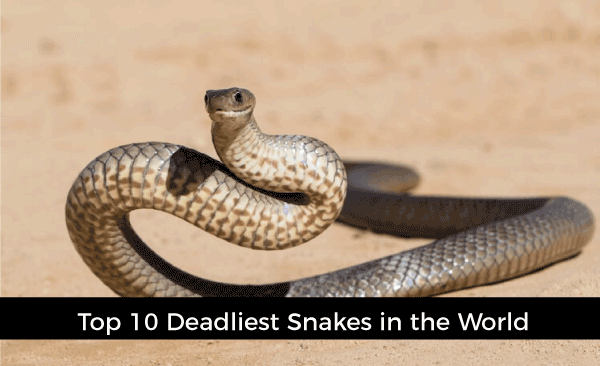
1. Inland taipan
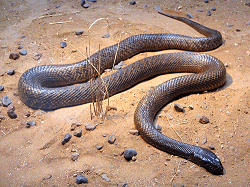
According to the study released in the Journal of Neuropharmacology, the inland taipan is one of the most dangerous snakes. Even a minuscule portion of its toxin can kill mammals (or humans). They live in Queensland and South Australia’s floodplains, tucked away in clay crevices, usually inside the pre-dug burrows of different animals. According to the Australian Museum, the inland taipan, which lives in more distant areas than the coastline taipan, barely comes into conflict with humans. When the taipan senses danger, it twists its body into a rigid S-shape before leaping out in a single or numerous bites.
The hyaluronidase enzyme is a key component of its venom that distinguishes it from other species. This enzyme boosts the permeation of the poisons throughout the victim’s body.
2. Coastal taipan
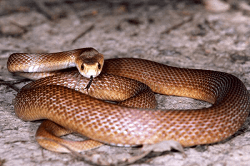
According to the Australian Museum, the coastline taipan (Oxyuranus scutellatus) may sting you multiple times before you detect it because of its incredible speed. This snake, which lives in the damp jungles of tropical and temperate coastal areas, can lift its entire body off the ground and leap fangs-first into its adversary, injecting venom.
According to Australian Geographic, this snake’s bite was almost invariably lethal until 1956, when an efficient anti-venom was developed.
3. King cobra
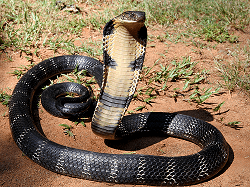
The king cobra (Ophiophagus hannah) is the world’s largest deadly snake and measures up to 18 feet long (5.4 m), as per the Natural History Museum in London.
When attacked, a king cobra would flare out its “hood,” or the skin over its head, using specific ribs and musculature in its neck. According to the Smithsonian Institution, the snake’s acute vision enables it to see an approaching person from a distance of around 330 feet (100 meters). Moreover, as per the San Diego Zoo, these snakes can also elevate their heads off the surface, approximately 1/3 of their body length.
Its standout feature is the amount of venom delivered into victims, not the potency of the venom. According to the Fresno Zoo, each bite delivers roughly 7 milliliters (around 0.24 fluid ounce) of venom, and the snake typically attacks with 3 or 4 bites in rapid succession. As per Sean Carroll, a biological researcher at the University of Maryland, a single bite can kill a human in 15 minutes and an adult elephant in just a few hours.
4. Banded krait
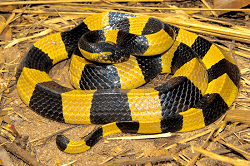
According to a 2016 study published in the journal PLOS Neglected Tropical DiseasesThe banded krait (Bungarus fasciatus) moves slowly during the day and is more likely to bite at night. The snake’s poison can immobilize reflexes and prevent the diaphragm from moving. As a result, the air is effectively blocked from reaching the lungs, resulting in suffocation.
5. Saw-scaled viper
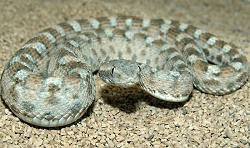
The saw-scaled viper (Echis carinatus) is the smallest of India’s “Big Four,” which includes Russell’s viper, ordinary krait (Bungarus caeruleus), and Indian cobra (Naja naja). According to a journal statement, when frightened, this snake commences “sizzling” by spreading apart specialized serrated scales instead of making the typical snake “hissing” sound. After being stung by this snake, a person will experience regionalized swelling, agony, and blood.
According to the educational association “Understanding Animal Research”, the venom interferes with a person’s capacity to clot blood and can cause internal bleeding and eventually severe kidney failure. According to Understanding Animal Research, for a human to survive, hydration and anti-venom (there are 9 kinds of anti-venom for this snake) must be given within hours of the bite.
6. Russell’s viper
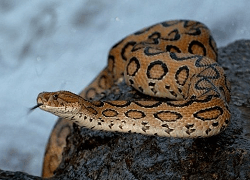
Snakebites kill over 58,000 people in India each year, according to a report published in the journal PLOS Neglected Tropical Diseases on March 25, 2021. These deaths are caused by Russell’s viper (Daboia russelii). This variety is among the most lethal of the actual vipers, according to researchers who published their findings in the journal Toxins in 2021.
They cause substantial fatality among paddy farmers in Sri Lanka, where this midnight viper prefers to repose in paddy fields. The snake’s venom can induce symptoms, including quick renal dysfunction, excessive bleeding, and multi-organ damage. According to researchers who published their findings in the Manual of Clinical Neurology in 2014, victims usually die of renal failure. Acute strokes and, in rare cases, symptoms comparable to Sheehan’s syndrome, in which the pituitary gland ceases generating specific hormones, can be caused by some constituents of the poison-related to coagulation.
7. Eastern tiger snake
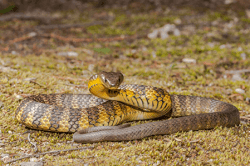
This snake is typically around 1.2-1.6 meters long; however, some have been known to grow over 2 meters long. The Eastern Tiger Snake can be found in coastal locations and hilly places west of Sydney. It favors grassy regions near water; however, it can also be found far from water. This snake is timid and will leave if given the opportunity, but it will bite if threatened and unable to flee. Though, these snakes are extremely dangerous and venomous.
This snake is lighter brown to grayish, with paler crossbars, and can even be olive in color. Its underbelly varies in color from cream to golden. According to the University of Adelaide, its strong venom can induce poisoning in humans in as little as 15 minutes after a sting and is accountable for a minimum of one fatality every year.
8. Boomslang
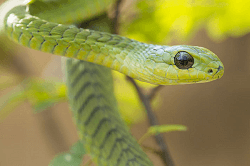
For many years, this snake was thought to be innocuous, but world-renowned herpetologist Karl P. Schmidt discovered that it is a badass. Schmidt was attacked on the hand while studying a baby boomslang in 1957. Schmidt didn’t think much of it because no one had warned him that these snakes were lethal. He succumbed to respiratory failure and brain hemorrhage in just one day, prompting researchers to investigate the snake’s venom, which was unexpectedly proved to be very deadly.
The effects of this snake’s poison are dangerous. Its hemotoxic, which means it kills red blood cells, impairs the clotting process, and damages tissue and organs. Unfortunately, this results in a major hemorrhage, with the person bleeding from the gums, nose, and other orifices. Due to the massive internal bleeding, the victim’s body might sometimes turn blue. In addition, the procedure can be incredibly sluggish, with the person dying of internal bleeding after 5 days. Thankfully, there is anti-venom, so don’t wait if you’re attacked by one of these creatures.
The boomslang is the looker, with an egg-shaped cranium, large eyes, and a bright-green striped body. As per the South African National Biodiversity Institute, when exposed, boomslang would distend its neck to twofold its size and show a brilliantly colored fold of skin amongst its scales. A boomslang bite might result in a terrible death. According to Scientific American, “Blood will start leaking out of every potential move, especially the gums and nostrils, and even the slightest of incisions, can lead to significant muscle and brain hemorrhaging. Blood will begin to travel through the victim’s body through their feces, urine, saliva, and puke until they die.”
9. Fer-de-lance
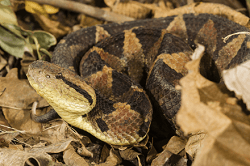
The Fer-de-Lance can be identified by their large, flattened head that stands out from the remainder of their body. This species’ ventral side varies in color from yellow to whitish-grey, with dark dots on the posterior end. The dorsal side can be any color (olive, grey, brownish, dark brown, tan, or nearly black) and features lateral dark triangles with pale edges. This species is sexually dimorphic, with females growing substantially faster than males by seven to twelve months after birth. Adults can grow to reach around 4 and 6 feet tall and weigh up to 13 pounds. Females measure around 8.2 feet in length, which is unusual.
A bite from a fer-de-lance snake can induce a human to hemorrhage because the snake’s poison comprises an anticoagulant (a chemical that prevents blood from clotting). And if that isn’t enough to deter you, consider this: As per the University of Costa Rica, a mother can have 90 ferocious offspring.
10. Black mamba
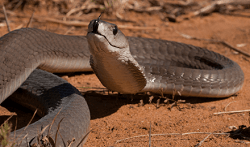
As per Live Science, the black mamba (Dendroaspis polylepis), Africa’s poisonous snake, can kill a person with just two drops of venom. Black mambas have a brownish tone, and their name comes from the darker, inky color of their jaws. They’re roughly 8 feet (2.5 meters) long and can travel at a pace of 12 miles per hour (19 kilometers per hour).
The long reptiles are hatched with 2 to 3 drops of poison in each of their fangs, making them fatal biters right away. Kruger National Park claims that they can retain up to 20 droplets for each of their fangs by the time they reach adolescence.
A strike from this Tropical snake is almost usually fatal if not treated. The venom of a black mamba has the following effects on the human body: According to Ryan Blumenthal of the University of Pretoria, when venom is administered, it disrupts function at a confluence where nerves and muscles interact, resulting in paralysis. The poison is also cardiotoxic, which means it can cause cardiac collapse. According to Blumenthal, this was the situation with a South African person was attacked by a black mamba on his forefinger. Within twenty minutes of reaching the clinic, he reported a cardiac arrest. According to Blumenthal, despite receiving anti-venom treatment, the man died a few days later.
Researchers are not certain how many persons are killed by black mambas each year, but as per Blumenthal’s research, the snake kills the most people in southern Africa.
